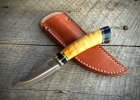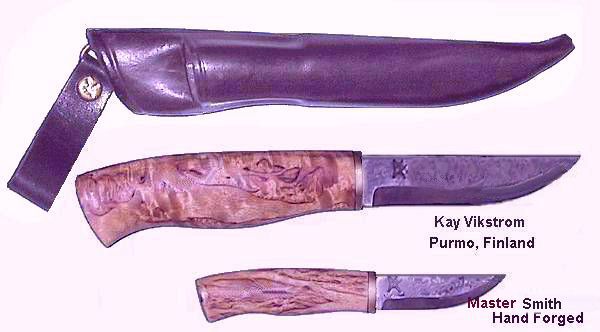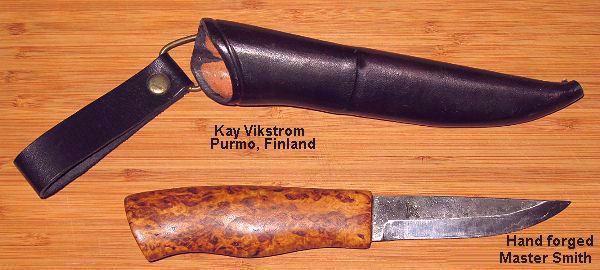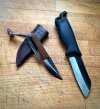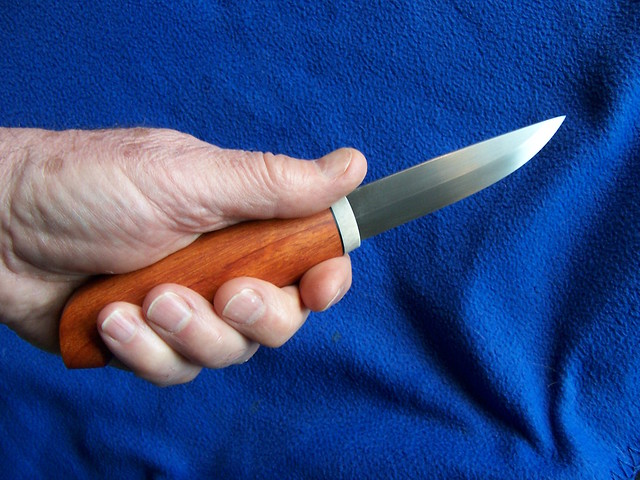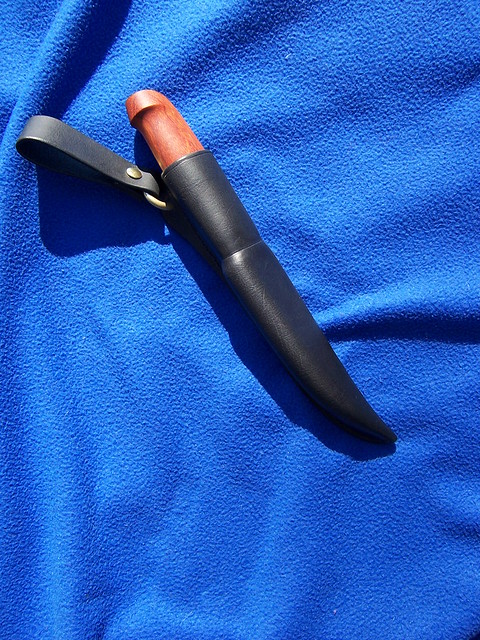Olavi Kemppainen OK
According to Kainuun, this was original maker of Tommi puukot. Others do not agree.
Mark:
"OK"
"When Antti Kemppainen died in 1972, there were no Hyrynsalmi Tommi specialists. However, the boy, Olavi Kemppainen, continued in his footsteps and got the know-how continued to further the family legacy. From that turning point, the number of blacksmiths began to grow slowly. Today, the new blacksmiths are produced mainly from community college knife-making courses."
Often said to me [to be] the best of the Kemppainen brothers.
"Grim, you have a Tommi made by Olavi Kemppainen. We need pics of it He was considered the best of the three Kemppainen brothers, I think, but here I need the help of some finnish mates member.
By the way, Tommi puukkos are first of all wood workers (haven't find a better blade shape for it), then hunters and fishers knives. For carving and fishing it's better a pointed shape, for hunting a more bellied one. It would be good to discuss a bit with the smith that will make it. "
Frederick 89 At Bladeforums
“I first got interested in knives when I saw my father’s collection of puukkos. When I was young boy I used puukkos often for wood carving and I made my first one in 1997.
I´m the first bladesmith in my family and in the beginning I was self-taught. Soon after, though, I got advice about puukkos, the most important ones of which I got from
Olavi Kemppainen,
the master of Tommi-puukko from Kuhmo, Finland. Then I studied and graduated as metal-artisan. Additionally my damascus master is Jean-Jose Tritz from Hamburg, Germany. I am also a bladesmith journeyman."
Mikko Inkeroinen
Yes Olavi Kemppainen. who with his brother "AK" owned and operated Kainuum Puukko for many years (over 50 yrs ?) They were the 'knowledge keepers' of K[H]alle Keranen's method & style of making the Tommi Puukko.
\
Olavi is said to have made the best of all Kainuum puukkos."
Joonas Kallioniemi (2009): "AK and
OK are Alpo Kempppainen and
Olavi Kemppainen. Many consider them to be one of the best puukko smiths, although Olavi doesn't make puukkos any more due to health reasons."
Per Kainuun Puukko, the self-proclaimed "official" maker of Tommi puukot: "Olavi Kemppainen moved the knife-making skills and traditions forward by teaching the secrets of the real Tommi knife manufacturing to Veijo Käpylä and [he passed them [along to]... Kainuun Puukko's current owner and the only [current maker,] ... Marko Lindele. The [current self-proclaimed "official"] ... Tommi knife can now be recognized by its ML-initialed characters."
OK's puukot are in museums:
http://www.kantapuu.fi/objectinfo.p...0&prms=s_start=11820&s_class=2&s_adv[0]=Hardy
Per Nordiska Knivar (translation from Finish):
"Finland, 1870. Close to Hyrynsalmi, in the region of Kainuu, South Karelia, lived Kalle Keränen (1844-1912) a young self-taught blacksmith who had heard that a metallurgist from England was arriving at Fiskars to teach the rudiments of forging and oil quenching. At that time Finland was going through a period of bad famine, so Kalle decided to go south, learn new things and look for better luck. He packed his ruckpack and set off on foot. He was about to march for 730 km.
It was probably Edward Hill, another metallurgist and teacher at Fiskars, that brought oil quenching concept to Finland. Kalle became the pupil of Thomas Woodward, with which he further perfected his forging technique and experienced oil quenching. Three years in the noisy south were more than enough for Kalle, so he soon decided to return to his forests and to his smithy.
Kalle began to forge knives regularly after his return from Fiskars and gave his own interpretation of the Kainuu regional style. It was a simple puukko with 11 cm barrel handle and 10 cm rhombic blade with slightly hooked tip. However, the latter peculiarity was later abandoned in favor of a completely straight spine. Kalle named the knife in honor of his master, from Thomas, Tommi.
His knives were good tools and earned great success thanks to the excellent quality of the blade. They became famous even outside its province and other smiths began to forge following his style. It is however uncertain when the knife acquired completely its technical and aesthetic features, now widely recognized. Kalle’s knives became even more famous and customers started to call him Tommi. With the passage of time the blacksmith became simply Tommi, he was a good knife maker and a good drinking mate
After his death, his son Setti continued the father’s work and introduced the larger models that would have had an important part during the Winter War and the struggle for Finnish independence from Russian domination. The larger Tommis would have been used as short swords in close combat fights and as leave gift for graduates.
The Tommi is the only Finnish puukko to have developed a such defined own tradition and to be so famous beyond the borders of Finland. The eighth Finnish president, Urho Kekkonen, a eager hunter, used to keep one in a drawer of his desk and in various occasions used these knives as a gift for political collegues.
Today the tradition is kept alive by other makers as such as Mauri Heikkinen
mauriheikkinen.fi/ Jukka Hankala
http://www.hankala.com/ and Pentti Kaartinen
http://www.tommipuukko.com/index.htm. Veijo Käpylä at Kainuun Puukko
http://www.kainuunpuukko.com/"
 [/url][
[/url][ 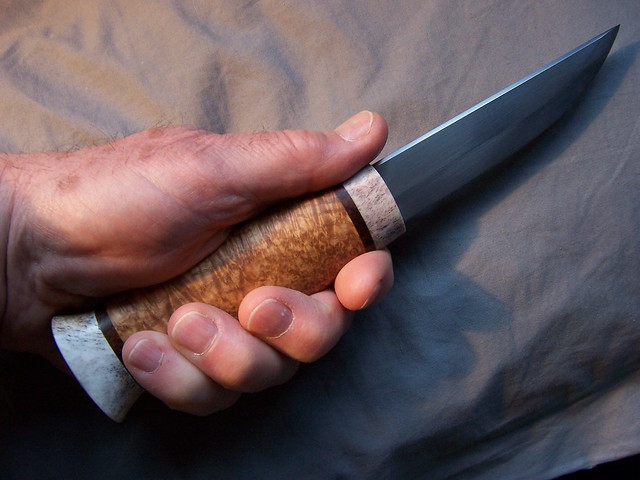
 /158694019@N03/]
/158694019@N03/]

 /158694019@N03/]
/158694019@N03/]


